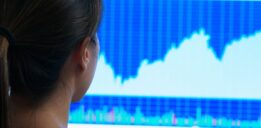This Number Shows that a Major Stock Market Crash Is Likely
Mark my words, key stock indices are treading in very dangerous waters. A stock market crash could become the reality soon. Investors beware!
Yes, I understand that talking about a potential stock market crash isn’t popular these days. Nobody likes to discuss bad things when everything looks great. Have you seen the key stock market indices lately? They are making new highs.
But it’s important to remain levelheaded and not get complacent. As markets go higher, we’re seeing a lot of irrationality and complacency among investors. Too many people are calling for a much higher stock market. Stocks are getting expensive across the board; perhaps too expensive.
Look at the cyclically adjusted price-to-earnings (CAPE) ratio of the U.S. stock market. The CAPE ratio is the price-to-earnings (P/E) ratio adjusted for inflation and volatility in earnings. Consider it a better measure of the stock market than the plain vanilla P/E ratio. The CAPE ratio currently stands at 30.73. (Source: “Online Data Robert Shiller,” Yale University, last accessed September 22, 2017.)
What Does This Number Mean?
The CAPE ratio by itself doesn’t mean much, but the historical average—and the CAPE figures during the previous market tops—can really tell us a lot.
With this said, there have only been two instances when CAPE ratio was higher than it is now: 1) in 1929, and 2) between 1997 and 2002. After both of these periods, a broad and rigorous market sell-off followed (aka a stock market crash).
Could we see something like that happen now? It’s quite possible.
But don’t just stop there; keep the mean reversion in mind as well. It’s a theory which suggests that asset prices eventually come back down to their historical average. In previous stock market crashes, the CAPE ratio fell very close to its long-term average.
The long-term average of the CAPE ratio since 1881 is around 16.8. By this measure, U.S. stock markets are trading about 83% above their historical average.
If the CAPE ratio goes back to its long-term average, there are only two possible outcomes: 1) earnings miraculously increase immensely or 2) the stock market crashes. It’s hard to see much more improvement on earnings, given the poor economic conditions in the U.S. and globally—and the Federal Reserve’s trend of increasing interest rates. So, the latter scenario looks more likely.
How Low Could Stocks Go?
Dear reader, the higher that the key stock indices go, and the more expensive that stocks get, the bigger the stock market crash is going to be. Stock markets tend to fall to their major support levels in times of a sell-off.
Please look at the chart below of the S&P 500 Index.

Chart courtesy of StockCharts.com
The above chart shows that the next major support level for the S&P 500 isn’t until 1,850. If we assume that this is the level where the next stock market crash will take the S&P 500, it would mean a decline of more than 25%.
When will the sell-off begin? If anyone claims they can tell you the exact time or price point of a stock market crash, run. They are likely going to be wrong, since it’s impossible to pinpoint these things. The markets could still go much higher than they are today. Never disregard irrationality; it does weird things.
But I am highly convinced that the returns in the next three years are going to much lower than the returns in last three. We may not be at the market top yet, but we are closing in on it.






